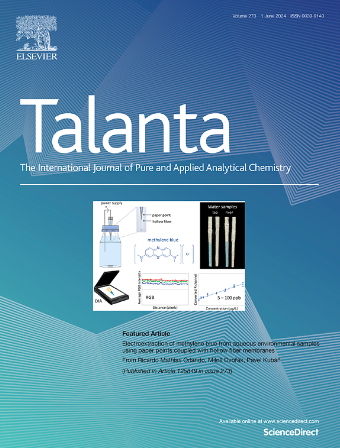深度学习辅助表面增强拉曼光谱检测细胞内活性氧物种
IF 5.6
1区 化学
Q1 CHEMISTRY, ANALYTICAL
引用次数: 0
摘要
实现细胞内活性氧(ROS)的智能分析有利于疾病的快速诊断。本文将表面增强拉曼光谱(SERS)技术与深度学习相结合,建立了一种基于神经网络的细胞内ROS智能检测方法,提高了SERS的分析能力。以同时检测过亚硝酸盐(ONOO-)和次氯酸盐(ClO-)为模板,在AuNPs上修饰4-巯基苯硼酸(4-MPBA)和2-巯基-4-甲氧基苯酚(2-MP)分子,制备出AuNP/4-MPBA/2-MP纳米探针。收集了AuNP/4-MPBA/2-MP纳米探针在ONOO-和ClO-特异响应前后的SERS光谱,构建了数据库,并建立了用于提取的神经网络模型(ENN)和用于定量的一维卷积神经网络模型(1D-CN)。ENN模型对ONOO-和ClO-相关光谱的余弦相似度值分别为0.997和0.995。此外,模型的定性和定量结果与实验结果基本一致。此外,模型还能准确提取ONOO-和ClO-的SERS响应谱信息,并实现其在活细胞中浓度的初步预测,在高通量智能处理和精确分析生物系统大规模复杂SERS数据方面具有巨大潜力。本文章由计算机程序翻译,如有差异,请以英文原文为准。

Deep learning-assisted surface-enhanced Raman spectroscopy detection of intracellular reactive oxygen species
Realizing the intelligent analysis of the intracellular reactive oxygen species (ROS) is beneficial to quick diagnosis of diseases. Herein, surface-enhanced Raman spectroscopy (SERS) technology was combined with deep learning to establish a smart detection method of intracellular ROS based on neural network to improve the SERS analysis ability. Taking the simultaneous detection of peroxynitrite (ONOO−) and hypochlorite (ClO−) as the templates, 4-mercaptophenylboric acid (4-MPBA) and 2-mercapto-4-methoxyphenol (2-MP) molecules were modified on the AuNPs to prepare AuNP/4-MPBA/2-MP nanoprobes. The SERS spectra of AuNP/4-MPBA/2-MP nanoprobes before and after the specific response of ONOO− and ClO− were collected to construct a database, and the neural network model for extraction (ENN) and one-dimensional convolutional neural network model (1D-CNN) for quantification were built. The cosine similarity values of ENN model for ONOO− and ClO− correlation spectra were 0.997 and 0.995, respectively. In addition, the qualitative and quantitative results of the models were basically consistent with the experimental results. Moreover, the models can accurately extract the SERS response spectral information of ONOO− and ClO− and realize their preliminary prediction of concentration in living cells, which has great potential in the high-throughput smart processing and accurate analysis of large-scale complicated SERS data from biological system.
求助全文
通过发布文献求助,成功后即可免费获取论文全文。
去求助
来源期刊

Talanta
化学-分析化学
CiteScore
12.30
自引率
4.90%
发文量
861
审稿时长
29 days
期刊介绍:
Talanta provides a forum for the publication of original research papers, short communications, and critical reviews in all branches of pure and applied analytical chemistry. Papers are evaluated based on established guidelines, including the fundamental nature of the study, scientific novelty, substantial improvement or advantage over existing technology or methods, and demonstrated analytical applicability. Original research papers on fundamental studies, and on novel sensor and instrumentation developments, are encouraged. Novel or improved applications in areas such as clinical and biological chemistry, environmental analysis, geochemistry, materials science and engineering, and analytical platforms for omics development are welcome.
Analytical performance of methods should be determined, including interference and matrix effects, and methods should be validated by comparison with a standard method, or analysis of a certified reference material. Simple spiking recoveries may not be sufficient. The developed method should especially comprise information on selectivity, sensitivity, detection limits, accuracy, and reliability. However, applying official validation or robustness studies to a routine method or technique does not necessarily constitute novelty. Proper statistical treatment of the data should be provided. Relevant literature should be cited, including related publications by the authors, and authors should discuss how their proposed methodology compares with previously reported methods.
 求助内容:
求助内容: 应助结果提醒方式:
应助结果提醒方式:


